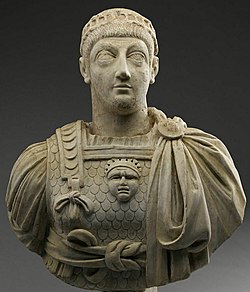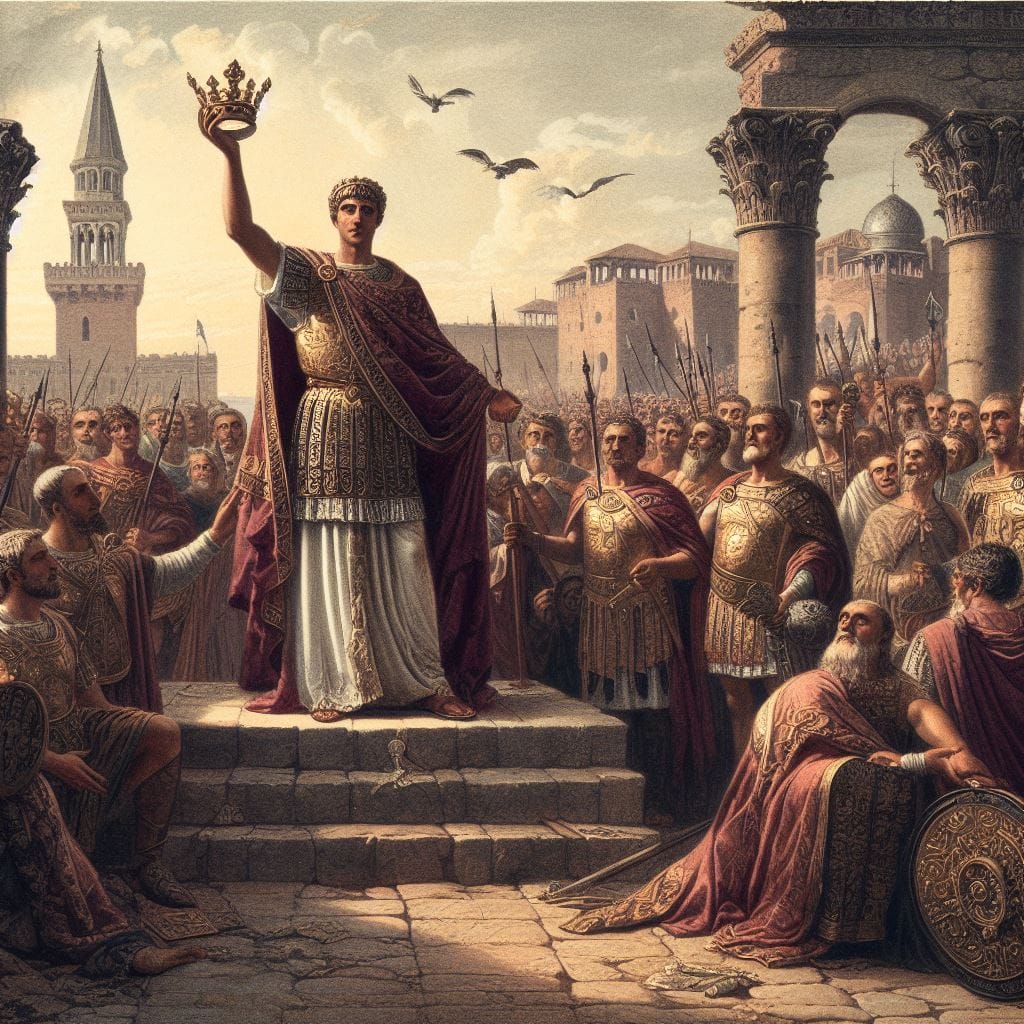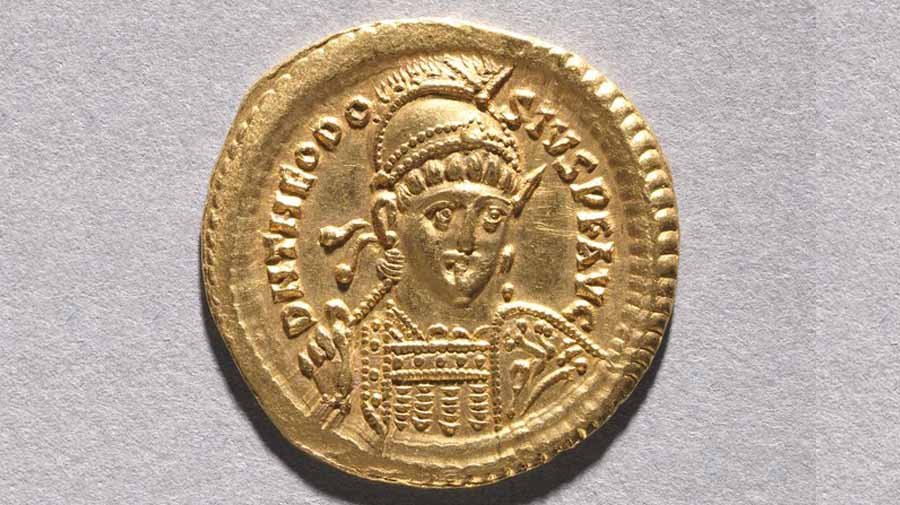Valentinian III: The Beleaguered Emperor of the Western Roman Empire
The era of the Western Roman Empire is marked by tumult, intrigue, and the struggle for survival against both internal discord and external threats. Among the rulers who navigated this era, few faced as many challenges as Valentinian III, whose reign from 425 to 455 AD witnessed some of the most pivotal events in Roman history. While his rule was not particularly distinguished by significant military or political successes, it provides a fascinating glimpse into the complexities of late imperial governance and the declining days of a once-mighty empire.
Early Life and Ascension to Power
Born Flavius Placidius Valentinianus in 419 AD in Ravenna, Valentinian III was the son of Galla Placidia and Constantius III. Galla Placidia, his mother, was the daughter of Theodosius I, and an influential figure in her own right. His father, before his death in 421, served briefly as a co-emperor, marking Valentinian’s lineage with imperial distinction from the outset.
Valentinian's journey to the throne was largely orchestrated by his mother, who wielded considerable power as regent. The political landscape of the Western Roman Empire at the time was immensely fragmented, with external pressures from barbarian tribes such as the Visigoths, Vandals, and Huns, and internal challenges from ambitious generals and senators. Valentinian’s cousin, Theodosius II, who was the Eastern Roman Emperor, played a vital role in supporting his ascent by declaring him Augustus at just six years old in 425 AD, after ousting the usurper Johannes.
The Regency of Galla Placidia
The early years of Valentinian’s reign were dominated by Galla Placidia’s regency. During this period, the empire was beset by numerous challenges that Galla managed with remarkable political acumen. One of her significant achievements was the settlement of various disputes with barbarian tribes, most notably establishing a temporary peace with the Visigoths, who had been a constant threat since they famously sacked Rome in 410 AD.
Despite these diplomatic achievements, Valentinian’s reign was undermined by internal power struggles. Galla Placidia had to navigate a treacherous political environment filled with ambitious generals, such as Aetius, Boniface, and Felix, each vying for control and influence at court. Her ability to maintain relative stability until Valentinian came of age is a testament to her political skill.
Valentinian and the Influence of Aetius
Upon reaching maturity, Valentinian III assumed more direct control over the empire, though his reign continued to be overshadowed by more competent military leaders. Aetius, a prominent Roman general known for his battlefield prowess and political machinations, emerged as the most influential figure during Valentinian’s reign. Aetius played a crucial role in defending the empire from external threats, most notably the Huns under their infamous leader, Attila.
The dynamic between Valentinian and Aetius was complex, with the emperor relying heavily on the general’s military successes while simultaneously feeling threatened by his substantial influence. Aetius’s victory against Attila in the Battle of the Catalaunian Plains in 451 AD is often credited with delaying the collapse of the Western Roman Empire. However, this victory could not mask the reality of the empire’s increasing vulnerability and waning resources.
The Decline of Imperial Authority
Valentinian III’s reign is characterized by the gradual erosion of imperial authority, as the Western Roman Empire struggled against both internal weaknesses and external threats. The once-formidable army of Rome had diminished in both number and morale, heavily reliant on barbarian mercenaries who were often as much a threat as they were allies. The empire’s territorial losses continued unabated, with significant regions such as Africa falling prey to the Vandals.
Valentinian’s leadership style, marked by indecision and reliance on advisors, did little to halt this decline. His administration was plagued by corruption and inefficiency, exacerbating the empire’s financial woes. The central power of the emperor was increasingly circumscribed by powerful generals and governors, who often acted with near-autonomous authority in their respective regions.
The growing impotence of the central government during Valentinian’s reign was further highlighted by the notorious sack of Rome in 455 AD by the Vandals, led by King Gaiseric. This event symbolized the disintegration of Roman power and influence in the west, although Valentinian himself did not live to witness it, as he was assassinated in the same year.
Assassination and Aftermath
Valentinian III’s death marked the end of a turbulent and largely ineffective reign. His assassination was the result of a conspiracy led by two disgruntled followers of Aetius, whom Valentinian had murdered in 454 AD in a misguided bid to consolidate his power. This act of betrayal, however, only served to further destabilize the political landscape, leaving the Western Roman Empire without a clear successor and accelerating its path toward eventual collapse.
The aftermath of Valentinian’s assassination was characterized by chaos and the rapid succession of weak emperors who were unable to rectify the significant challenges facing the empire. As the Western Roman Empire tottered on the brink of dissolution, Valentinian’s legacy became yet another chapter in the narrative of decline, exemplifying the myriad challenges of maintaining an empire in the face of overwhelming odds.
In summation, Valentinian III's reign offers a poignant reflection of the broader struggles of the Western Roman Empire during its decline. The combination of internal strife, external pressures, and a faltering leadership heralded the end of an era, one marked by profound transformations that would reshape the Mediterranean world. As we continue to unravel the complexities of his reign, we gain invaluable insights into the final chapters of one of history's most storied empires.
The Influence of External Pressures
The reign of Valentinian III was dramatically shaped by the persistent threat from external forces. Foremost among these were the Huns, a nomadic group from the Central Asian steppes who struck fear into the heart of both the Eastern and Western Roman Empires. Led by the formidable Attila, the Huns posed an existential threat to the Roman world. Attila's campaigns during the 5th century showcased both his strategic acumen and the vulnerabilities of a declining Roman military.
The threat of the Huns was a pervasive element in Valentinian's rule, culminating in direct conflicts and complex diplomatic relations. The Western Roman Empire, strained by its own internal divisions and resource deficits, often found itself at the mercy of barbarian forces. Valentinian's administration had to navigate a precarious balance—attempting to buy peace with gold or negotiate alliances that would protect Roman interests without ceding too much power.
The Battle of the Catalaunian Plains
One of the defining moments of Valentinian's military history was the Battle of the Catalaunian Plains, fought in 451 AD. This confrontation between Roman and Hun forces has been immortalized as one of the most significant and brutal battles of the late Roman Empire. The Roman coalition, led by the astute general Aetius and supported by Visigothic allies, faced Attila's Huns in the northeastern part of modern-day France.
The battle itself was a bloody affair, steeped in legend as much as historical record. Although it ended with neither a decisive victory nor a complete defeat for either side, it marked a crucial defensive stand against Hun expansion. Aetius's ability to forge alliances and rally defensive forces underlined his strategic genius and further underscored Valentinian's reliance on capable military leaders.
Despite its ambiguous outcome, the battle represented a temporary check on Hun advancement into Western Europe, preserving remnants of Roman territorial integrity. However, the costly struggle revealed the dire condition of the Roman military structure, increasingly dependent on federate troops and hastily brokered agreements with other barbarian groups.
Internal Instability and Political Machinations
The Western Roman Empire's external adversities were exacerbated by internal instability. Valentinian's reign was characterized by a web of political intrigue involving ambitious generals, opportunistic politicians, and shifting allegiances. The power politics of the Roman court often overshadowed governmental efforts to address the empire's mounting challenges.
Galla Placidia's influence during the early years of Valentinian's reign was rooted in her ability to manage these political complexities. Her regency provided a veneer of stability, yet the underlying tensions continued to simmer. The rivalry between prominent generals such as Aetius and Boniface, and their respective supporters, created an environment of distrust and fracture within the Roman elite.
The murder of Aetius in 454 AD, ordered by Valentinian himself, epitomized the paranoia and volatility that characterized the emperor’s later years. Although Aetius's removal temporarily quashed one power bloc, it destabilized the empire further by eliminating one of its most competent defenders. The vacuum left by Aetius's death became a crucible of discord, effectively dismantling any remaining cohesion within the Roman military and political system.
The Vandal Sack of Rome
The volatility of Valentinian's regime culminated in the sack of Rome by the Vandals in 455 AD. Unlike the Visigoths' earlier sack in 410, the Vandal incursion was marked by massive plundering and destruction. Led by King Gaiseric, the Vandals capitalized on the empire's vulnerability following Valentinian's assassination.
The sacking of Rome served as a devastating symbolic blow to Roman prestige and power. It epitomized the inability of the Roman state to defend its heartland and projected a message of Rome’s fading dominance across Europe and the Mediterranean. The event drove home the reality of an empire in disarray, unable to marshal the resources or unity needed to repel barbarian incursions.
In the capital's wake of devastation, questions arose concerning Rome’s capacity to govern and protect its shrinking territories. The dwindling authority of the central government, influenced by continuous barbarian pressures and evolving Roman-barbarian identities, precipitated discussions about the future structure of Roman power and the potential reshaping of its territories.
The Legacy of Valentinian III
Despite the challenges that marked his reign, Valentinian III remains a pivotal figure for understanding the Roman Empire’s twilight years. His rule encompassed a complex mix of short-lived triumphs overshadowed by profound failures, reflecting the immense pressures faced by late Roman leadership as it struggled to adapt to shifting geopolitical realities.
Valentinian's legacy lies not so much in what was achieved during his tenure but rather in what was left unresolved. His reign witnessed the transformation of Rome from a dominant empire to a fragile state, where the ties binding its territories were stretched to their breaking point. Under his rule, the interwoven fates of Rome and the barbarian states began to create a new socio-political landscape that would define Europe for centuries to come.
The study of Valentinian III's reign offers insights into the complexities of imperial governance during a period of dire transition. It illuminates the challenges of leadership amidst internal factionalism and external threats, serving as a poignant reminder of how profoundly the fabric of an empire can be transformed by pressures both within and beyond its borders.
As we examine the ebb and flow of power during Valentinian's era, we are reminded of the intricate legacy of the Roman Empire—a legacy of grandeur and decay, of stability and collapse—and the enduring lessons it imparts upon the tapestry of human history.
The Role of Religion and Cultural Shifts
Amidst the political and military struggles of Valentinian III’s reign, religion and cultural transformations played crucial roles in shaping the Western Roman Empire during this era of decline. By the 5th century, Christianity had become deeply entrenched in Roman life, influencing governance, societal norms, and even conflicts. Valentinian's reign bore witness to the continued rise of the Church as a powerful institution within the Roman framework, tasked with uniting the diverse and often fractious territories of the empire under a shared faith.
Galla Placidia, Valentinian's mother, was a devout Christian and took an active role in promoting the influence of the Church during her regency. This influence extended to supporting ecclesiastical leaders, undertaking church-building initiatives, and resolving doctrinal disputes that sometimes threatened imperial stability. The Church served as a unifying force but also a source of tension, as religious debates often paralleled political ones, such as the contentious conflict over Nestorianism, which divided different Roman and ecclesiastical communities.
The Impact of Barbarian Integration
As the fabric of Roman society evolved, so too did its relationship with the very barbarian groups often seen as adversaries. The era of Valentinian III was marked by growing barbarian integration into the Roman system, as reflected in both military and cultural exchanges. These interactions forced changes in the identity and structure of Roman life.
Barbarians were increasingly essential to the Roman military and political hierarchy. Their leaders, such as the Visigothic King Theodoric I and the Vandal King Gaiseric, wielded significant influence and often maneuvered for favorable positions within the Roman domain. Their federate troops, integrated into Roman armies, were vital for defense, as demonstrated during engagements like the aforementioned Battle of the Catalaunian Plains.
This integration brought both challenges and innovations to the Roman Empire. On the one hand, it contributed to the erosion of traditional Roman identity, raising questions about allegiance and the cultural future of the empire. On the other hand, it facilitated cultural exchange, bringing new ideas, practices, and even governance models that would later influence the medieval European landscape.
The Transition Towards the Medieval Era
The fall of the Western Roman Empire was not an abrupt end but a gradual transition—a shift from the ancient world to the medieval era. Valentinian III’s reign, with its mix of resilience and decay, encapsulates this pivotal transformation. The sociopolitical dynamics that existed during his rule laid down the scaffolding for what would emerge as the distinct European political entities and cultures that characterized the Middle Ages.
This era saw the Roman concept of central authority waning, replaced by localized governance structures where power was often decentralized. The collapse of effective Roman rule in the West led to the degradation of cities and infrastructure, contributing to what has historically been termed the "Dark Ages." Nevertheless, amidst this decline was also a foundation for renewal, as successor states and emergent powers such as the Kingdom of the Franks and the Byzantine Empire began to define the new political and cultural map.
Underpinning this evolution was the resilient institution of the Church, which preserved many Roman traditions and championed continuity amidst change. By maintaining Latin as the lingua franca of sacred and academic endeavor, the Church provided a bridge between Rome's classical past and Europe's medieval future.
Examining Valentinian III’s Legacy
Valentinian III’s reign provides a rich tapestry from which historians can examine the multifaceted decline of Roman power in the West. While often overshadowed by more charismatic figures in Roman history, Valentinian’s reign reveals the intricate and often fragile balancing act required to manage an empire beset with challenges both inherited and emergent.
At the heart of his legacy is the realization of how leadership, in times of tumultuous change, grapples with internal fragmentation and pervasive external threats. Valentinian's attempt to stabilize and defend his realm, alongside his reliance on others like Aetius, highlights the limits of imperial command in an era of constrained resources and expanding external pressures.
Valentinian's story stands as a cautionary tale about the importance of adaptability, alliance-building, and the recognition of emerging social and cultural forces. It invites a re-examination of the mechanisms by which great political states endure or falter under the weight of shifting historical currents.
In essence, studying Valentinian III and his reign not only offers insights into the intricacies of late Roman imperial politics but also into the broader narrative of transformation that swept the ancient world toward the medieval. As historians continue to uncover and interpret the legacies of such pivotal figures, we glean a deeper understanding of how the echoes of their decisions resonate through the corridors of history, influencing the course of human events long after their immediate contexts are forgotten.






Comments